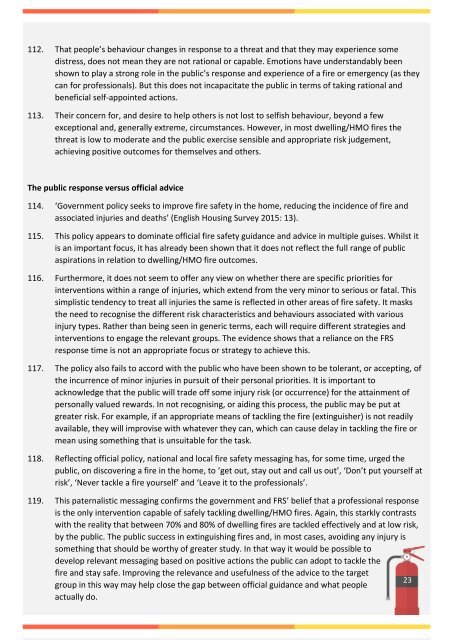An evaluation of the role of fire extinguishers
A report considering the role of a fire extinguisher in human terms identifying the gap between policy assumptions and the evidence from real fires. It considers the implications arising from this and makes a number of recommendations to create an evidence base and enhance current fire safety policies/advice.
A report considering the role of a fire extinguisher in human terms identifying the gap between policy assumptions and the evidence from real fires. It considers the implications arising from this and makes a number of recommendations to create an evidence base and enhance current fire safety policies/advice.
You also want an ePaper? Increase the reach of your titles
YUMPU automatically turns print PDFs into web optimized ePapers that Google loves.
112. That people’s behaviour changes in response to a threat and that <strong>the</strong>y may experience some<br />
distress, does not mean <strong>the</strong>y are not rational or capable. Emotions have understandably been<br />
shown to play a strong <strong>role</strong> in <strong>the</strong> public’s response and experience <strong>of</strong> a <strong>fire</strong> or emergency (as <strong>the</strong>y<br />
can for pr<strong>of</strong>essionals). But this does not incapacitate <strong>the</strong> public in terms <strong>of</strong> taking rational and<br />
beneficial self-appointed actions.<br />
113. Their concern for, and desire to help o<strong>the</strong>rs is not lost to selfish behaviour, beyond a few<br />
exceptional and, generally extreme, circumstances. However, in most dwelling/HMO <strong>fire</strong>s <strong>the</strong><br />
threat is low to moderate and <strong>the</strong> public exercise sensible and appropriate risk judgement,<br />
achieving positive outcomes for <strong>the</strong>mselves and o<strong>the</strong>rs.<br />
The public response versus <strong>of</strong>ficial advice<br />
114. ‘Government policy seeks to improve <strong>fire</strong> safety in <strong>the</strong> home, reducing <strong>the</strong> incidence <strong>of</strong> <strong>fire</strong> and<br />
associated injuries and deaths’ (English Housing Survey 2015: 13).<br />
115. This policy appears to dominate <strong>of</strong>ficial <strong>fire</strong> safety guidance and advice in multiple guises. Whilst it<br />
is an important focus, it has already been shown that it does not reflect <strong>the</strong> full range <strong>of</strong> public<br />
aspirations in relation to dwelling/HMO <strong>fire</strong> outcomes.<br />
116. Fur<strong>the</strong>rmore, it does not seem to <strong>of</strong>fer any view on whe<strong>the</strong>r <strong>the</strong>re are specific priorities for<br />
interventions within a range <strong>of</strong> injuries, which extend from <strong>the</strong> very minor to serious or fatal. This<br />
simplistic tendency to treat all injuries <strong>the</strong> same is reflected in o<strong>the</strong>r areas <strong>of</strong> <strong>fire</strong> safety. It masks<br />
<strong>the</strong> need to recognise <strong>the</strong> different risk characteristics and behaviours associated with various<br />
injury types. Ra<strong>the</strong>r than being seen in generic terms, each will require different strategies and<br />
interventions to engage <strong>the</strong> relevant groups. The evidence shows that a reliance on <strong>the</strong> FRS<br />
response time is not an appropriate focus or strategy to achieve this.<br />
117. The policy also fails to accord with <strong>the</strong> public who have been shown to be tolerant, or accepting, <strong>of</strong><br />
<strong>the</strong> incurrence <strong>of</strong> minor injuries in pursuit <strong>of</strong> <strong>the</strong>ir personal priorities. It is important to<br />
acknowledge that <strong>the</strong> public will trade <strong>of</strong>f some injury risk (or occurrence) for <strong>the</strong> attainment <strong>of</strong><br />
personally valued rewards. In not recognising, or aiding this process, <strong>the</strong> public may be put at<br />
greater risk. For example, if an appropriate means <strong>of</strong> tackling <strong>the</strong> <strong>fire</strong> (extinguisher) is not readily<br />
available, <strong>the</strong>y will improvise with whatever <strong>the</strong>y can, which can cause delay in tackling <strong>the</strong> <strong>fire</strong> or<br />
mean using something that is unsuitable for <strong>the</strong> task.<br />
118. Reflecting <strong>of</strong>ficial policy, national and local <strong>fire</strong> safety messaging has, for some time, urged <strong>the</strong><br />
public, on discovering a <strong>fire</strong> in <strong>the</strong> home, to ‘get out, stay out and call us out’, ‘Don’t put yourself at<br />
risk’, ‘Never tackle a <strong>fire</strong> yourself’ and ‘Leave it to <strong>the</strong> pr<strong>of</strong>essionals’.<br />
119. This paternalistic messaging confirms <strong>the</strong> government and FRS’ belief that a pr<strong>of</strong>essional response<br />
is <strong>the</strong> only intervention capable <strong>of</strong> safely tackling dwelling/HMO <strong>fire</strong>s. Again, this starkly contrasts<br />
with <strong>the</strong> reality that between 70% and 80% <strong>of</strong> dwelling <strong>fire</strong>s are tackled effectively and at low risk,<br />
by <strong>the</strong> public. The public success in extinguishing <strong>fire</strong>s and, in most cases, avoiding any injury is<br />
something that should be worthy <strong>of</strong> greater study. In that way it would be possible to<br />
develop relevant messaging based on positive actions <strong>the</strong> public can adopt to tackle <strong>the</strong><br />
<strong>fire</strong> and stay safe. Improving <strong>the</strong> relevance and usefulness <strong>of</strong> <strong>the</strong> advice to <strong>the</strong> target<br />
group in this way may help close <strong>the</strong> gap between <strong>of</strong>ficial guidance and what people<br />
actually do.<br />
23<br />
1




